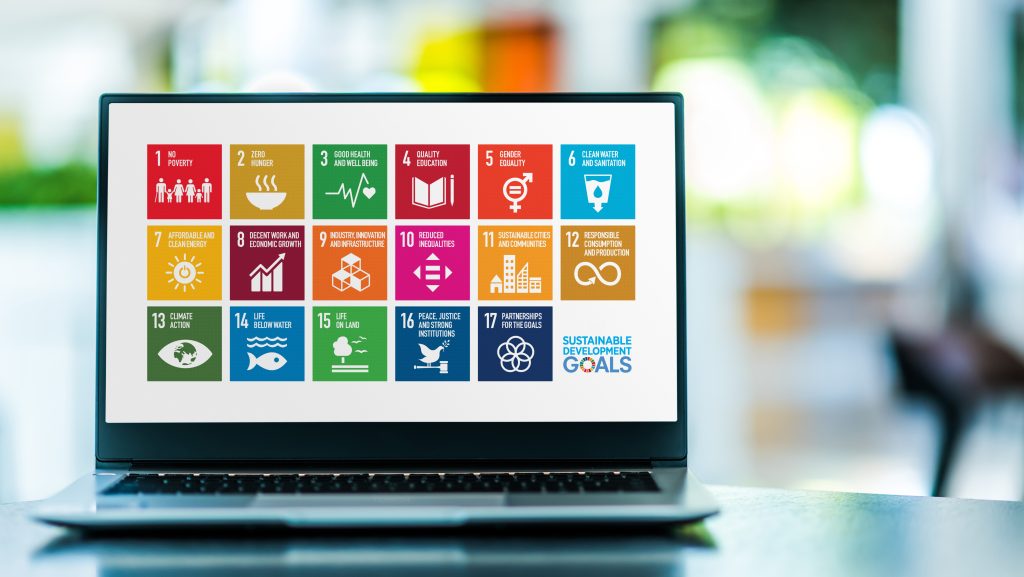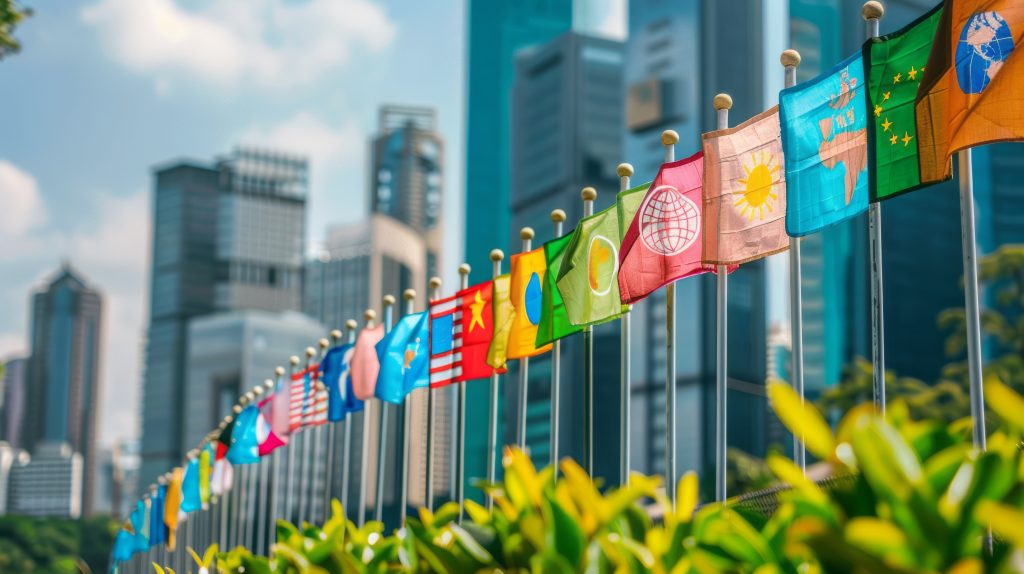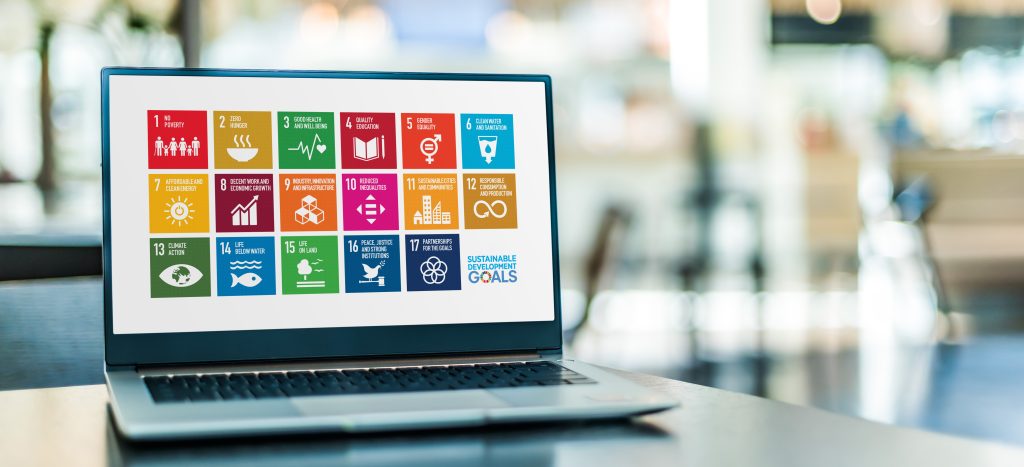Investing in SDGs: Guiding global impact and sustainable returns


Navigating the path to a sustainable, resilient, and inclusive future requires global participation. The journey may seem daunting, but the approach is simple: one step at a time. The United Nations Sustainable Development Goals (UN SDGs) play a pivotal role in guiding each step.
Introducing the UN SDGs
The Sustainable Development Goals (SDGs) are 17 interconnected goals established by the UN in 2015. The purpose of achieving these goals is to tackle the world’s most pressing challenges.
The goals cover a wide range of issues, including combatting poverty and hunger, promoting comprehensive healthcare and education, achieving gender equality, and addressing climate change.
Below, we included a simple guide to investing in SDGs, which also breaks down the purpose of each goal.
Each SDG is accompanied by specific targets and indicators to measure progress. Originally intended to guide governments and policymakers, these goals have also become a powerful framework for businesses, investors, and individuals.
The impact and opportunity of investing in SDGs
Particularly in developing nations, significant investment is required to meet these goals—an estimated additional $4 trillion annually. 1 This financial gap presents a dual opportunity: to alleviate global challenges and to cultivate new sustainable markets.
Investors have the chance to support innovations such as clean energy solutions, accessible digital education, and advanced medical treatments for underserved populations.
For retail investors interested in contributing to a sustainable future, investing in SDGs can be a way to achieve both social and environmental impacts alongside financial gains. This approach helps build a more resilient and prosperous world for future generations.

A simple guide to investing in SDGs
The UN SDGs and ways to engage as an investor
Click through each of the 17 Sustainable Development Goals below to learn more about the issue at hand, key statistics and ways to invest.
A tip from us: Bookmark this article by adding it to your search engine’s ‘favourites’ bar to always have a simple guide to the UN SDGs on hand.
This SDG aims to eradicate poverty in all its forms by 2030. Despite significant progress in reducing extreme poverty over the last few decades, over 700 million people worldwide live on less than $1.90 a day.
- If current trends continue, by 2030, 575 million people will still be living in extreme poverty
Source: End poverty in all its forms everywhere, United Nations
Ways to invest in SDG 1:
One way to invest in SDG 1 is by identifying businesses that are creating new jobs, expanding into underserved areas and targeting businesses in less developed countries and with vulnerable populations.
Furthermore, companies can implement programs to economically empower disadvantaged groups and ensure decent working conditions across their own business and supply chain.
Example investments:
Microfinance, Development Bank Debt, Digital Finance Platforms
SDG 2 focuses on ending hunger, achieving food security, improving nutrition, and promoting sustainable agriculture. It recognises the critical role of the food and agriculture sector in addressing development challenges and eradicating hunger and poverty.
- 1 in 3 people worldwide struggle with moderate to severe food insecurity
- More than 600 million people worldwide are projected to face hunger in 2023
Source: End hunger, achieve food security and improved nutrition and promote sustainable agriculture, United Nations
Ways to invest in SDG 2:
To invest in SDG 2, identify companies with services aimed at improving food security and nutrition for underserved populations. This can also include products and services that make food production more efficient and reduce wastage.
Example investments:
Agricultural Technology, Consumer Staples (i.e. food and drinks companies), Water Infrastructure
Goal 3 emphasises the importance of ensuring healthy lives and promoting well-being for all ages. It underscores the significance of quality healthcare services, disease prevention, and overall well-being to achieve a prosperous and sustainable world.
- Out-of-pocket payments for health pushed or further pushed 381 million people (4.9% of the population) into extreme poverty
Source: Ensure healthy lives and promote well-being for all at all ages, United Nations
Ways to invest in SDG 3:
To invest in SDG 3, a good starting point is emphasising the promotion of healthy lifestyles and the development and improvement of the healthcare sector through drug discovery or the building of hospitals and other medical facilities.
Example investments:
Healthcare, Biotechnology, Medical Equipment and Supplies
SDG 4 focuses on the transformative power of education in empowering individuals and communities, contributing to social progress and driving economic growth. Despite slow progress, the world is falling far behind in achieving quality education.
- Low- and lower-middle-income countries face a nearly $100 billion annual financial gap to reach their education targets
Source: Ensure inclusive and equitable quality education and promote lifelong learning opportunities for all, United Nations
Ways to invest in SDG 4:
One can invest in SDG 4 by engaging in areas like education and vocational training, educational publishing, and university bonds.
Example investments:
Education Services, Digital Learning Platforms, Publishing and Learning Resources
The fifth SDG emphasises gender equality as a fundamental human right crucial for building a peaceful, prosperous, and sustainable world. Unfortunately, the world is not currently on track to achieve gender equality by 2030.
- At the current rate, it will take 140 years to achieve equal representation in leadership in the workplace
Source: Achieve gender equality and empower all women and girls, United Nations
Ways to invest in SDG 5:
To invest in SDG 5, engage with women-led businesses, women-focused businesses, businesses that promote gender equality through ensuring equal pay, and those that are increasing female representation in leadership.
Example investments:
Women-led businesses, Companies with strong gender equality practices, Microfinance
Access to safe water is considered essential for sustainable development and is a fundamental human need that impacts health, sanitation, and overall quality of life. Water scarcity, compounded by conflicts, climate change, and pollution, poses a dual threat to both human well-being and environmental sustainability worldwide.
- 81% of species dependent on inland wetlands have declined since 1970
- In 2022, 2.2 billion people lacked safely managed drinking water and 3.5 billion lacked safely managed sanitation
Source: Ensure availability and sustainable management of water and sanitation for all, United Nations
Ways to invest in SDG 6:
To invest in SDG 6, start by identifying businesses that contribute to the global goal of ensuring clean water and sanitation for all.
Example investments:
Water Utilities and Infrastructure, Water Technology, Wastewater Recycling
SDG 7 recognises that access to affordable and clean energy is crucial for sustainable development, as it underpins economic growth, environmental protection, and social well-being. To ensure access to clean energy for all by 2030, we must accelerate electrification, increase investments in renewable energy sources and invest in improving electricity grids.
- 675 million people still live in the dark; 4 in 5 of them are in sub-Saharan Africa
Source: Ensure access to affordable, reliable, sustainable and modern energy for all, United Nations
Ways to invest in SDG 7:
To invest in SDG 7, one can support initiatives that bring together businesses, governments, and civil society to develop innovative clean energy solutions and improve accessibility.
Example investments:
Renewable Energy Generation, Battery Storage, Grid Efficiency
This goal focuses on promoting inclusive, productive employment, and decent work for all. It emphasises the importance of creating conditions that enable people to have quality jobs, which are essential for reducing poverty and fostering economic development.
- 1 in 4 young people are not in education, employment or training, with young women more than twice as likely as young men to be in this situation
Source: Promote sustained, inclusive and sustainable economic growth, full and productive employment and decent work for all, United Nations
Ways to invest in SDG 8:
One can invest in SDG 8 by identifying companies that promote decent work, have positive labour practices and support entrepreneurship.
Example investments:
Employment and Skills Development Companies, Companies with strong fair employment practices, Development Bank Debt
SDG 9 highlights the role of industry in driving economic growth, job creation, and technological advancement. The goal calls for the building of resilient infrastructure, promotion of inclusive and sustainable industrialisation, and fostering of innovation.
- Energy-related CO2 emissions reached 36.8 billion metric tons in 2022, a record high
Source: Build resilient infrastructure, promote inclusive and sustainable industrialization and foster innovation, United Nations
Ways to invest in SDG 9:
To invest in SDG 9, one route is by identifying governmental debt, supra-governmental debt, or technologies that improve infrastructure efficiency and enhance industrial processes.
Example investments:
Education Providers, Labelled Bonds, Development Bank Debt
Goal 10 aims to reduce inequalities within and among countries. It emphasises the need for universal policies that address the needs of disadvantaged and marginalised populations to create a more equitable society.
- In 2022, refugee numbers hit a record high of 34.6 million, 41% of them were children
Source: Reduce inequality within and among countries, United Nations
Ways to invest in SDG 10:
In order to invest in SDG 10, one method is to direct capital towards initiatives that aim to bridge social and economic disparities. In addition, one could engage with companies and policymakers to advocate for fairer labour practices.
Example investments:
Social Housing, Social Outcome Bonds, Development Bank Debt
This goal envisions a future where cities provide opportunities for all residents, ensuring access to basic services like energy, housing, and transportation. It emphasises sustainable urban development to create inclusive and resilient communities.
- Globally, only one in two urban residents have convenient access to public transportation
Source: Make cities and human settlements inclusive, safe, resilient and sustainable, United Nations
Ways to invest in SDG 11:
To invest in SDG 11, investors can support the development of sustainable and resilient urban infrastructure, such as renewable energy systems, public transportation, affordable housing, and waste management solutions.
Example investments:
Pollution Control, Sustainable Civil Engineering, Electrified Transportation
By promoting responsible consumption and production patterns, SDG 12 drives sustainable practices that minimise waste generation, reduce environmental impact, and ensure efficient resource use.
- On average, each person wastes 120 kilograms of food per year
Source: Ensure sustainable consumption and production patterns, United Nations
Ways to invest in SDG 12:
One way to invest in SDG 12 is by identifying companies that prioritise responsible consumption and production practices, such as reducing waste, promoting recycling, and adopting sustainable supply chain management.
Example investments:
Waste Management, Resource Efficiency, Sustainable Packaging Firms
Goal 13 addresses the urgent need to take action against climate change. It highlights the global challenge posed by climate change and emphasises the importance of mitigation, adaptation, and resilience-building efforts.
- The rate of sea-level rise has doubled in the last decade
- Global climate finance flows reached an annual average of $803 billion in 2019-2020, however, developing countries require nearly $6 trillion by 2030
Source: Take urgent action to combat climate change and its impacts, United Nations
Ways to invest in SDG 13:
To invest in SDG 13, engage with businesses developing technologies, products, and services aimed at mitigating climate change impacts and supporting climate adaptation efforts.
Example Investments:
Forestry, Climate Technology, Carbon Credits
Urgent action is needed to preserve the planet’s largest ecosystem. This goal emphasises the careful management of marine resources to protect marine ecosystems, combat pollution and promote sustainable fishing practices.
- One in five fish caught originates from illegal, unreported and unregulated fishing
Source: Conserve and sustainably use the oceans, seas and marine resources for sustainable development, United Nations
Ways to invest in SDG 14:
One can invest in SDG 14 by engaging with projects and initiatives focused on conserving and restoring marine ecosystems, reducing marine pollution and sustainably managing fish stocks.
Example investments:
Sustainable Fisheries and Aquaculture, Supply Chain Traceability Systems, Plastic Circularity Firms
SDG 15 recognises that a fundamental shift in society’s relationship with nature is essential. It aims to sustainably manage forests, combat desertification, halt biodiversity loss, and reverse land degradation. It underscores the importance of preserving terrestrial ecosystems for biodiversity conservation and sustainable development.
- The world is currently facing the largest species extinction event since the dinosaur age
- 100 million hectares (two times the size of Greenland) of healthy and productive land was degraded every year from 2015-2019
Source: Protect, restore and promote sustainable use of terrestrial ecosystems, sustainably manage forests, combat desertification, and halt and reverse land degradation and halt biodiversity loss, United Nations
Ways to invest in SDG 15:
To invest in SDG 15, focus on companies that develop and implement nature-based solutions, such as sustainable forestry, ecosystem restoration, and biodiversity conservation initiatives.
Example Investments:
Forestry, Environmental Remediation, Regenerative Agriculture Systems and Suppliers
Ongoing and new conflicts around the world are derailing a global path to peace. Goal 16 focuses on promoting peaceful societies with access to justice for all by building effective, accountable institutions.
- One quarter of humanity lives in conflict-affected areas
Source: Promote peaceful and inclusive societies for sustainable development, provide access to justice for all and build effective, accountable and inclusive institutions at all levels, United Nations
Ways to invest in SDG 16:
Political and social stability are crucial factors for investors who wish to invest in SDG 16, as they provide a more predictable and secure environment for their investments. Engaging with institutions to improve their governance, transparency and respect for the rule of law could involve active engagement, voting, and collaboration with other investors and stakeholders.
Example investments:
Government Bonds, Development Bank Bonds, Cybersecurity
The final SDG underscores the need for collaboration among governments, businesses, civil society, and other stakeholders to achieve the SDGs by leveraging resources and expertise. According to the UN, progress on SDG 17 has been mixed, with some advances in areas like development aid and access to technology, yet funding remains a significant challenge.
- As of November 2022, 37 out of 69 of the world’s poorest countries were in debt distress or at high risk of it
Source: Strengthen the means of implementation and revitalize the Global Partnership for Sustainable Development, United Nations
Ways to invest in SDG 17:
To engage in SDG 17, investors can drive better transparency and accountability in their investments, while working with institutions and governments to drive change.
Example investments:
Telecommunications, Emerging Market Capacity Building, Government and Development Bank Bonds
Footnotes
-
How to narrow the investment gap for global goals, UN Trade & DevelopmentScroll to footnote





